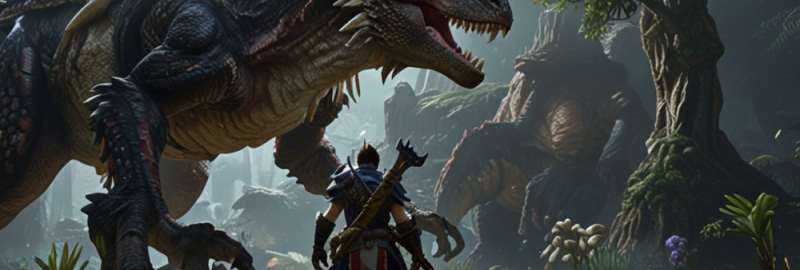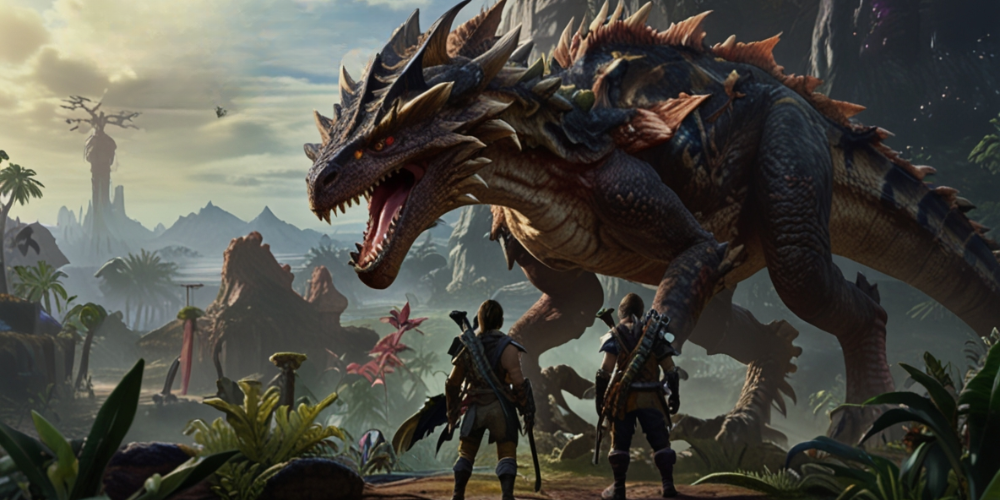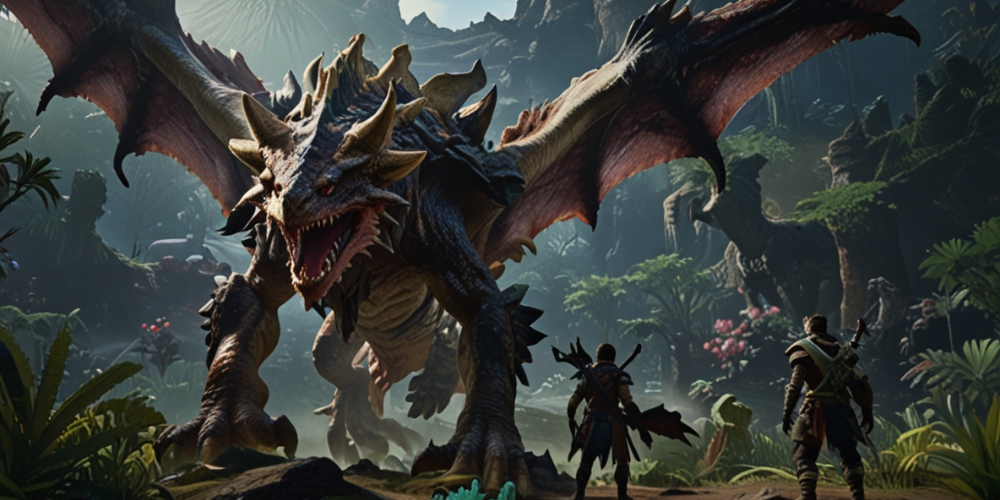
As a remarkable action RPG, Monster Hunter: World has garnered widespread acclaim, immersing players in an expansive world teeming with breathtaking wildlife. Part of its allure lies in its immersive lore, which enriches the experience of hunting monumental beasts. Each monster is woven into the tapestry of the game's narrative, offering players insight into their behaviors, habitats, and significance within the environment.
The Great Jagras: Apex of Adaptation
The Great Jagras epitomizes adaptation in the wild. This monster, often found prowling the Ancient Forest, uses its camouflaging abilities to blend seamlessly with its surroundings. This characteristic reflects the delicate balance of nature. The lore surrounding this creature highlights its role as a predator and its crucial place in the food chain. From its iridescent scales to the unique mechanics of its hunting behavior, the Great Jagras exemplifies how life strives to survive in a harsh ecosystem.
Radobaan: The Rolling Oddity
Radobaan presents a contrast with its bizarre and amusing nature. Residing in the Rotten Vale, this spherical creature rolls around, utilizing its armored shell to defend itself. The legend surrounding Radobaan speaks to the symbiotic relationships seen in nature, as it often carries the remnants of the flora and fauna of its home. This monster embodies recycling and environmental balance themes, reminding hunters that even the unlikeliest creatures have a vital role in maintaining ecosystem equilibrium.
Anjanath: The Dinosaur of the Forest

Among the more formidable predators, Anjanath stalks the landscapes with an impressive physique and a lumbering gait. Its lore tells of a creature that represents the apex predator. With its fiery breath and keen senses, Anjanath’s menacing presence in the Ancient Forest showcases the survival of the fittest concept. Additionally, its interactions with other species create a captivating interplay of predator and prey, further enhancing the immersive storytelling aspect of the game.
Tobi-Kadachi: The Agile Electromancer
Tobi-Kadachi offers a dynamic gameplay element through its unique combination of agility and electrical attacks. Its lore suggests that this creature has adapted to its forest home, utilizing its speed and electricity to navigate the dense underbrush effectively. It embodies the thrill of the hunt, as players must constantly adjust their strategies when dealing with its erratic movements. Engaging with Tobi-Kadachi adds layers of excitement, making every encounter distinctly memorable.
Barroth: The Mud Behemoth
Barroth thrives in the arid deserts, utilizing its mud-strewn body as a vital aspect of its defense. The creature's lore reflects resilience and adaptability to harsh climates. By digging through the sand and mud, Barroth nurtures the ecology of its environment, showcasing the connections between monsters and their habitats. Encountering Barroth provides a unique challenge, as players must confront not only its strengths but also the landscapes it inhabits.
Diabolos: The Burrowing Terror

In the desert regions, Diabolos reigns supreme, embodying fear and ferocity. The lore surrounding this formidable monster speaks of its ability to burrow underground, launching surprise attacks on unsuspecting hunters. The tension surrounding each encounter establishes a thrilling atmosphere, marking Diabolos as a creature at the heart of desert mythology. It serves not just as a boss monster but as a symbol of primal instincts and survival strategies in the harsh desert environment.
Rathalos: The King of the Skies
Rathalos stands as one of the iconic monsters in the Monster Hunter universe, often hailed as the king of the skies. Its lore encompasses tales of honor and territory, painting it as a regal predator fiercely protective of its domain. This creature’s majestic appearance and aerial prowess add depth to its character, making every encounter feel like a battle against a fierce royalty. It also invites players to explore themes of conservation and respect for nature, which resonate throughout the game.
Vaal Hazak: The Corrupting Force
The eerie essence of Vaal Hazak brings forth themes of decay and lethargy. Found in the Rotten Vale, this monster connects to the decomposition cycle, reminding players of the inevitability of life and death in nature. Its influence can be felt in the environment, where the presence of miasma alters the landscape and affects both creatures and hunters. Engaging with Vaal Hazak creates a haunting atmosphere, compelling players to confront the darker aspects of the ecosystem.
Nergigante: The Elder Dragon of Destruction

Nergigante is entangled in the myths surrounding Elder Dragons, representing a force of nature that embodies chaos. Its aggressive and relentless demeanor reflects the game’s captivating storytelling, showcasing themes of ancient powers clashing with the hunter's resolve. The lore of Nergigante presents it as a destructive entity, yet its life cycle intertwines with the delicate balance of ecosystems, challenging players to understand their place within this vast world.
Odogaron: The Beast of Bloodlust
Odogaron captivates players with its speed and ferocity, exuding a distinct air of danger. Hailing from the Rotten Vale, its lore is steeped in blood and survival instincts. The connection between Odogaron and the decaying environment showcases the primal forces in play and the relentless cycle of life in the wild. Players discover that dealing with Odogaron demands a keen understanding of both its tactics and the environment in which it thrives, enriching the overall gameplay experience.
Xenojiiva: The Celestial Enigma
Xenojiiva presents a unique narrative that ties into the overarching story of Monster Hunter: World. As a being that emerges from an otherworldly source, its lore challenges players to confront the cosmic forces that influence the ecosystem. Encountering Xenojiiva culminates the player's journey, providing a rich narrative experience steeped in mystery and the consequences of humanity's actions on nature. The aesthetic of Xenojiiva elevates the gameplay experience, creating a memorable and visually stunning final encounter.
Zorah Magdaros: The Walking Mountain
Zorah Magdaros is not merely a monster but a colossal being whose existence affects the entire world. Its lore connects players to broader themes of balance and coexistence as this creature moves slowly through regions, reshaping landscapes. The interactions with Zorah Magdaros evoke questions about humanity’s impact on nature and the interdependence found within ecosystems. Engaging with this monster emphasizes teamwork, as the scale of its presence requires collaborative strategies that resonate with the game’s core values.
Teostra: The Flame Emperor

Teostra embodies elegance and power and is often referred to as the Flame Emperor. Its lore emphasizes the duality of beauty and danger, as this creature commands the skies and governs fire. Teostra's presence adds a mythic quality to the gameplay, inviting players to confront not just the beast itself but the fiery essence it manipulates. Each encounter serves as a reminder of the elegance found in nature, where even the most beautiful aspects can wield tremendous force.
Connecting Through Culture: Monsters as Symbols
The variety of monsters in Monster Hunter: World represents a rich tapestry of cultural symbolism. Each creature reflects construct themes relevant to different cultures, such as survival, respect for nature, and the necessity of balance. This cultural depth adds layers to the lore, allowing players to engage with the game's mechanics and its wider narrative implications. As players immerse themselves in this elaborate world, they appreciate the artistry in crafting these monsters alongside their unique stories.
Visual Splendor: Aesthetic and Artistic Design
The aesthetic of Monster Hunter: World plays a key role in conveying the lore surrounding its myriad creatures. The intricate designs and beautifully rendered environments create a vivid tapestry, allowing players to appreciate the unique characteristics of each monster’s biology. This artistic direction enhances the storytelling, enabling players to grasp the ecological relationships' nuances and the mythologies underpinning each beast. Visual splendor is not merely a surface quality but is integral to delivering an emotionally resonant experience.
Environmental Storytelling: More Than Just a Hunt
Monster Hunter: World excels in environmental storytelling, enriching the lore through the ecological systems that habitat the game. The varied landscapes inhabited by monsters showcase the interplay between predator and prey, illustrating how the behaviors of one species affect others. Players understand how this world evolves organically, with atmospheric conditions changing in real-time and the monsters remaining tied to specific biomes. This aspect encourages players to engage deeply with the lore, discovering the richness of the ecosystem beyond mere hunts.